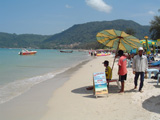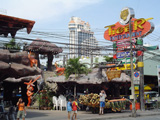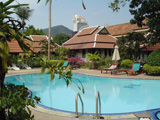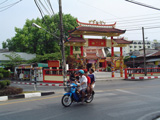| Bangkok Royal Palace |
Wat Trimitr | Wat
Po | Wat Benchamapophit |
 |
The
land of friendliness, rich of natural and anthropic wonders, of artistic and craft
traditions, of incontaminated beaches and tropical islands It is one of the most fascinating countries in the world!
Thailand
has more or less the same size of France (it is 1500 kilometres long, and 800
kilometres large) and spreads out in the south-east of the Asian continent. It
has a population of 60 millions inhabitants that speak Thai, a language similar
to Chinese that determines the meanings according to the intonation of the voice.
The history of this country is at least uncertain until the XIII century. It seems
that thai people comes from ancient populations from the south-east of China and,
nevertheless, recent archeological discoveries are an irrefutable witness of their
past millenary. After the XIII century followed different kings, with the capital
first in Sukhotai and then, for more than four centuries, in the fabulous city
of Ayuthaya.
With
a population of six millions inhabitants, Bangkok is characterized by a burstling
vitality, with a face of modern metropole, economically projected towards the
future, and at the same time with its precious features of town of the past, repository
of many treasures and of an ancient way of living. Here the business' managers
live together with the stalls' dealers and with the monks that go around begging
the food for the day with the bowl. Bangkok at the beginning was a small fishing
village dedicated to the river trade until 1872, but then it started a quick transformation
when the thai king Rama I decided, for defense problems against the mongolian
troops of Kublai Khan, to make it capital city instead of Ayuthaya. From then
the town did not give up growing. Nowadays, Bangkok is divided into two specific
towns delimited by the Chao Phraya river, the kings' river that crosses it: on
the west we find the quiet Thonburi, and on the east the proper town of Bangkok.
Undoubtly the great thai capital, called also "the Angels' town" by
its inhabitants, can offer to those who visit it an uncommon appeal, made up of
strong contrasts and of a unique atmosphere. It is possible to discover all this
in its historical suburbs, in particular the Royal Palace and the
different temples, or even the river town with its variegated markets. A visit
in the town starts from the symbol of the "Angels' town": the Royal
Palace, inside which we find also the Temple of Emerald Buddha. The Royal
Palace was built in four years, starting from 1782. It appears like a huge monumental
complex, surrounded by a white wall. The style is not the same, as during the
years it was subject to various integrations. The Royal Palace is still used nowadays
by the Royal Family to welcome authorities from all over the world, and as seat
of representation for cerimonies. Among the most visited and beloved buildings
of the Royal Palace there is Wat Phra Kaeo, more known
as Temple of the Emerald Buddha. Here can be found the most beautiful image of
Buddha in all the country. The temple is a structure composed by various chapels,
courts and colonnades, decorated with splendid golden stuccoes and fascinating
multicoloured glasses. It shelters paintings along the walls, many statues and
rich inlays in wood and mother-of-pearl. The other famous temples of the town
are: Wat Arun, the Temple of Dawn, that can be reached by ferry:
it is 79 metres high and it's charming to wacht it with the sunset light; Wat
Po, called also the Temple of the Reclining Buddha, famous as it shelters
a 46-metre long and 15-metre high statue; Wat Benjamabophit, the
Marble Temple built at the beginning of the century with Carrara marble, where
it is possible to meet the buddhist monks with their vivid tunics. On the south
side of Chinatown there is Wat Trimitr, the Temple of the Golden
Buddha. 40 years ago, this buddha covered with stucco was found near the port
of Bangkok, but while it was transported to Wat Trimitr, it was made fall by accident,
the stucco broke down and revealed a solid gold buddha, 3 metres high that weighted
five tonnes! Probably the buddha had been covered by stucco in order to hide it,
when the Burmen invaded Ayuthaya in the XVIII century. During the cooler hours
of the day it is also worth to climb the Golden Mountain, the artificial
hill that is found in the compound of Wat Saket, from where the
view of Bangkok can be admired. In order to understand the mood and the habits
of the "Angels' town", an excursion along its thick net of canals undoubtly
represents a privileged point of view: it will be possible to plunge in the classic
atmosphere of the river life, animated by commercial exchanges and typical landscapes.
Of great interest the itinerary that takes to the famous Damnoen Saduak
Floating Market, surely the most colourful market of all Thailand. It
is always very crowded, and particularly early in the morning, it is possible
to watch the animated exchange of wares and of different products by the inhabitants
of the villages in this area. Finally, 60 kilometres from Bangkok is situated
the town of Ayuthaya, which was the capital city of Thailand for 417 years.
It is a town that houses palaces and temples of extraordinary beauty, on which
soar more than 2000 golden spires that still nowadays leave an unforgettable memory
in the mind of those that visit it. |
Bang-Pa-In
Palace | Temple in
Phitsanulok | Hand
of Buddha Wat Sri Chum | The
stairs of Wat Doi Suthep |
The old charm of the North The North of
Thailand is an invitation to discover the roots of this country. On this vast
territory covered with valleys and montainous landscapes, can be met important
historical and cultural witnesses, villages where the time seems to have stopped,
ethnic groups and populations that follow the rythms of the seasons, adapting
rites and traditional feasts. Chiang Mai is surely a deep symbol of the
north of the country, ideal departure point to explore the territories of the
region. The Pink Town, as it is called, nowadays the second town in Thailand,
is located in very suggestive landscapes and is developed among beautiful hills,
rice fields and orchards. It shelters 300 temples, as witness of the deep web
between history and religion that characterizes its past. To visit the Wat
Chiang Man, the oldest temple of the town, the Phra Viharn Laikam
with its famous statue, the Phra Buddha Singh, and, 20 kilometres
from the centre, the Doi Suthep Temple and the summer residence
of the Royal Family, located among wonderful gardens. Among charming villages
and farms surrounded by bamboo woods, working buffalos, pagodas with golden spires
and an infinity of rice fields, the North proposes other towns of great interest.
Chiang Mai, the first thai capital is an example. The town is located in the northmost
point, in the area where Thailand meets Laos and Burma, the so called "Golden
Triangle". Even here the most important monuments are the temples, among
which Wat Phra Kaeo, that one upon a time contained the Emerald
Buddha, distinguishes itself. In many resorts in the North it is possible to find
shops with wonderful handmade objects, among which we remind the straw huts and
the original paper and silk umbrellas, made in the village of Borsang. In
order to visit the North leaving from Bangkok, a trip of 5 days/4 nights by mini-bus
is more than enough to discover the most interesting places. The first day visit
of Bang-Pa-In, Ayuthya and Phitsanulok.
Overnight in the Topland Hotel in Phitsanulok. The second day visit of Wat
Phra Sri Mahathat and then further to Sukhotai, Sri
Satchanalai e Chiang Mai. Overnight in the Rydges Hotel.
The following day visit of Wat Phra Singh, Wat Suan Dok
and Doi Suthep in Chiang Mai. The afternoon can be spent visiting
the craft villages, and the evening enjoying a Kantoke dinner. Overnight
in the Rydges Hotel. The fourth day the trip continues to Chiang Dao
to see the elephants, to make a ride on one of them and to watch their wonderful
show. Then, rafting of an hour along the Maekok river. Continuation to Ban
Ya Pa to meet the different ethnical groups, among which the famous long
neck women. Overnight in Chiang Rai, at the Dusit Island Resort
Hotel. The fifth day visit at the Golden Triangle: the zone near
the border which includes Thailand, Laos, Myanmar and China; then visit Chiang
Saen and Maesai. At 11.30 a.m. transfer to Chiang Rai aeroport
and flight to Bangkok. | |||
The
elephants in Chiang Dao village | The
famous long neck women in Ban Ya Pa village | Woman
that belongs to another ethnic group in the village | Near
the borders between Thailand and Myanmar |
Phuket | |||
 |  |  |  |
Patong
beach | In
the town centre in Patong | The
swimming pool of Baan Sukhotai hotel | Phuket
town centre |
| |||
Krabi | |||
Andaman
Resort beach | Ao
Nang without beach umbrellas | Hong
Island beach, Natural Park | Another
lonely beach of Hong Island |
In
the south-western coast of Thailand, in front of Phuket archipelago, from which
it is separated by 130 kilometres of sea spreaded of small and incontaminated
islands, there is Krabi, a locality that thanks to its magic beaches and
the extraordinary environment that surrounds it is meeting a growing touristic
success. Only recently discovered, Krabi has reached in a short time an important
position in the hit-parade of the touristic liking, thanks to the beatiful sea,
to its incontaminated beaches and overall to a coast characterized with rock formations
with unusual and strange forms, that give it an aspect with particular charm.
Some of the beaches are very rocky, especially when the shore remains uncovered
due to the strong low tide that can reach three metres. | |||
Koh
Lanta | |||
The
ferry to Koh Lanta | The
centre of Saladan village | One
of the petrol stations on the island | One
of the fantastic lonely beaches on the island |
To
reach Koh Lanta from Krabi it takes almost three hours by car, and it is
necessary to take the ferry twice. Beaches are very long and not busy at all,
some of them are absolutely with no tourists, therefore we can say that this island
is still a paradise far from the mass tourism. Even here it is possible to visit
the all island by motorbike in a day. The situation of the roads is not one of
the best: some parts of them are not asphalted and on the contrary when a car
passes along, clouds of red dust whip up from the soil. The petrol stations are
still made up of bins operated by krank gear. | |||